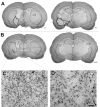Long-lasting functional disabilities in middle-aged rats with small cerebral infarcts
- PMID: 14645487
- PMCID: PMC6740989
- DOI: 10.1523/JNEUROSCI.23-34-10913.2003
Long-lasting functional disabilities in middle-aged rats with small cerebral infarcts
Abstract
Recommendations from experts and recently established guidelines on how to improve the face and predictive validity of animal models of stroke have stressed the importance of using older animals and long-term behavioral-functional endpoints rather than relying almost exclusively on acute measures of infarct volume in young animals. The objective of the present study was to determine whether we could produce occlusions in older rats with an acceptable mortality rate and then detect reliable, long-lasting functional deficits. A reversible intraluminar suture middle cerebral artery occlusion (MCAO) procedure was used to produce small infarcts in middle-aged rats. This resulted in an acceptable mortality rate, and robust disabilities were detected in functional assays, although the degree of total tissue loss measured 90 d after MCAO was quite modest. Infarcted animals were functionally impaired relative to sham control animals even 90 d after the occlusions, and when animals were subgrouped based on amount of tissue loss, MCAO animals with only 4% tissue loss exhibited enduring neurological-behavioral impairments relative to sham-operated controls, and the functional impairments in the group with the largest infarcts (20% tissue loss) were more severe than the functional impairments in the rats with 4% tissue loss. These results suggest that this model, using reversible MCAO to produce small infarcts and long-lasting functional-behavioral deficits in older rats, may represent an advance in the relatively higher-throughput modeling of stroke and its recovery in rodents and may be useful in the development and characterization of future stroke therapies.
Figures







References
-
- Abrous DN, Dunnett SB ( 1994) Paw reaching in rats: the staircase test. In: Neuroscience protocols, module 3 (Wouterlood FG, ed), pp 19-29. Amsterdam: Elsevier.
-
- American Heart Association ( 2001) Heart and stroke statistical update, 2000. Dallas: American Heart Association.
-
- Andersen MB, Zimmer J, Sams-Dodd F ( 1999) Specific behavioral effects related to age and cerebral ischemia in rats. Pharmacol Biochem Behav 62: 673-682. - PubMed
-
- Belayev L, Alonso OF, Busto R, Zhao WZ, Ginsberg MD ( 1996) Middle cerebral artery occlusion in the rat by intraluminal suture: neurological and pathological evaluation of an improved model. Stroke 27: 1616-1622. - PubMed
-
- Bland ST, Schallert T, Strong R, Aronowski J, Grotta JC, Feeney DM ( 2000) Early exclusive use of the affected forelimb after moderate transient focal ischemia in rats: functional and anatomic outcome. Stroke 31: 1144-1152. - PubMed
MeSH terms
LinkOut - more resources
Full Text Sources
Other Literature Sources
